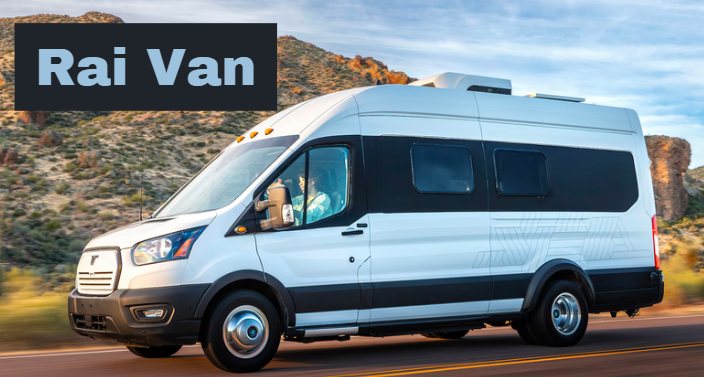A Rai Van, commonly known as a railway van, is a specialized vehicle designed for transportation on rail tracks. In the modern world, rai vans play a crucial role in logistics, ensuring the smooth and efficient movement of goods across vast distances.
This comprehensive article delves into the intricacies of rai vans, their significance in the transportation industry, their evolution over time, and their future prospects. By offering unique interpretations, analyses, and insights, this article aims to provide readers with an in-depth understanding of rai vans that surpasses existing online sources.
Introduction to Rai Van
A Rai Van, or railway van, is a specialized vehicle designed for transporting goods and materials on rail tracks. Unlike passenger carriages, rai vans are built to handle a wide range of cargo, from raw materials and industrial products to consumer goods and perishables. The concept of rai vans has been instrumental in revolutionizing the logistics and transportation industry, providing a reliable and cost-effective means of moving goods over long distances.
Historical Evolution of Rai Vans
Early Beginnings
The origin of rai vans can be traced back to the early days of rail transport in the 19th century. Initially, simple open wagons were used to carry coal, minerals, and other bulk commodities. These primitive rai vans were rudimentary in design but served their purpose of transporting heavy loads across short distances.
Industrial Revolution and Beyond
The Industrial Revolution marked a significant turning point in the development of rai vans. As industries grew and the demand for efficient transportation increased, more sophisticated and specialized rai vans were developed. Enclosed vans, refrigerated units, and tankers emerged, catering to a diverse range of goods.
Modern Era
In the modern era, rai vans have evolved into highly advanced and specialized vehicles. Innovations in materials, design, and technology have enhanced their capacity, durability, and efficiency. Today, rai vans are integral to global supply chains, supporting the movement of goods across continents.
Types of Rai Vans
Box Vans
Box vans are the most common type of rai van, featuring an enclosed design that protects cargo from weather and theft. They are used to transport a wide variety of goods, including electronics, clothing, and packaged foods.
Tanker Vans
Tanker vans are designed to carry liquids and gases, such as petroleum, chemicals, and beverages. These vans are equipped with specialized tanks that ensure the safe and secure transport of hazardous and non-hazardous materials.
Refrigerated Vans
Refrigerated vans, also known as reefers, are equipped with cooling systems that maintain specific temperature ranges. These vans are essential for transporting perishable goods like fresh produce, dairy products, and pharmaceuticals.
Flatbed Vans
Flatbed vans have an open design with a flat surface, allowing for the transport of oversized and heavy cargo. They are commonly used for transporting machinery, construction materials, and vehicles.
Hopper Vans
Hopper vans are specialized for transporting bulk materials like grains, coal, and ores. They feature a design that allows for easy loading and unloading through gravity-fed hoppers.
Design and Construction of Rai Vans
Materials
Modern rai vans are constructed using a variety of materials, including steel, aluminum, and composite materials. Steel provides durability and strength, while aluminum offers a lightweight alternative that enhances fuel efficiency.
Structural Components
The structural components of rai vans include the chassis, body, and suspension system. The chassis forms the foundation, supporting the weight of the cargo and ensuring stability on the tracks. The body is designed to accommodate different types of cargo, with specific features tailored to the van’s intended use.
Safety Features
Safety is a critical consideration in the design of rai vans. Modern vans are equipped with advanced braking systems, shock absorbers, and coupling mechanisms that enhance stability and prevent derailments. Additionally, many vans feature GPS tracking and monitoring systems to ensure the security of the cargo.
Operational Mechanics of Rai Vans
Loading and Unloading
Efficient loading and unloading are essential for the smooth operation of rai vans. Specialized equipment, such as cranes, forklifts, and conveyor belts, is used to handle different types of cargo. Automated systems are increasingly being adopted to streamline these processes and reduce human error.
Transportation and Logistics
Rai vans operate on a network of rail tracks, connecting major industrial hubs, ports, and distribution centers. The logistics of scheduling, routing, and coordinating the movement of rai vans is complex, requiring sophisticated software and real-time communication systems.
Maintenance and Upkeep
Regular maintenance is crucial to ensure the reliability and longevity of rai vans. Routine inspections, repairs, and upgrades are performed to address wear and tear, enhance safety, and comply with regulatory standards.
Significance of Rai Vans in Modern Logistics
Cost Efficiency
Rai vans offer a cost-effective solution for transporting large volumes of goods over long distances. The economies of scale achieved by rail transport reduce the per-unit cost of shipping, making it an attractive option for businesses.
Reliability and Timeliness
Rail transport is known for its reliability and punctuality. Unlike road transport, which can be affected by traffic congestion and weather conditions, rai vans operate on dedicated tracks, ensuring timely delivery of goods.
Environmental Benefits
Rai vans are a greener alternative to road and air transport. Rail transport produces significantly lower emissions of greenhouse gases and pollutants, contributing to environmental sustainability and reducing the carbon footprint of logistics operations.
Technological Advancements in Rai Vans
Automation and Digitalization
The advent of automation and digitalization has transformed the operation of rai vans. Automated loading and unloading systems, predictive maintenance technologies, and digital tracking tools enhance efficiency and reduce operational costs.
Smart Vans
Smart rai vans are equipped with sensors and IoT devices that provide real-time data on cargo conditions, location, and performance. This information enables proactive decision-making and enhances the overall efficiency of logistics operations.
High-Speed Rail
High-speed rail networks are emerging as a game-changer in the logistics industry. These networks facilitate faster movement of goods, reducing transit times and increasing the competitiveness of rail transport.
Environmental Impact and Sustainability
Reduced Emissions
Rai vans produce lower emissions compared to road and air transport, making them a more sustainable option for long-distance freight. The use of electric and hybrid locomotives further reduces the environmental impact of rail transport.
Energy Efficiency
Rail transport is inherently more energy-efficient than other modes of transport. The ability to move large volumes of goods with minimal energy consumption contributes to the sustainability of logistics operations.
Recycling and Reuse
Many components of rai vans, such as steel and aluminum, are recyclable. The recycling and reuse of these materials reduce the demand for new resources and minimize waste generation.
Challenges and Future Prospects
Infrastructure Development
One of the primary challenges facing the rail industry is the need for infrastructure development. Expanding and modernizing rail networks require significant investment and coordination between public and private stakeholders.
Regulatory Compliance
Rai vans must comply with a myriad of regulatory standards related to safety, environmental impact, and operational efficiency. Navigating these regulations can be complex and time-consuming.
Technological Integration
Integrating new technologies into existing rail systems poses a challenge. Ensuring compatibility, interoperability, and cybersecurity are critical considerations for the successful implementation of advanced technologies.
Future Prospects
The future of rai vans is promising, with advancements in technology and infrastructure poised to enhance their efficiency and competitiveness. The continued emphasis on sustainability and environmental responsibility will further drive the adoption of rail transport as a preferred logistics solution.
Case Studies: Successful Implementation of Rai Vans
Case Study 1: Efficient Supply Chain Management
A leading multinational corporation leveraged rai vans to streamline its supply chain operations. By integrating smart vans equipped with real-time tracking and monitoring systems, the company achieved significant cost savings and improved delivery times.
Case Study 2: Sustainable Logistics Solutions
A major logistics provider adopted electric rai vans as part of its commitment to sustainability. The use of electric vans reduced the company’s carbon footprint and enhanced its reputation as an environmentally responsible organization.
Case Study 3: High-Speed Rail Integration
A regional government invested in high-speed rail infrastructure to support local industries. The integration of high-speed rai vans facilitated faster movement of goods, boosting economic growth and attracting new businesses to the region.
FAQs
What is a Rai Van?
A Rai Van, or railway van, is a specialized vehicle designed for transporting goods on rail tracks. It is used to move a wide variety of cargo, including industrial products, consumer goods, and perishables.
How do Rai Vans differ from other freight transport vehicles?
Rai Vans differ from other freight transport vehicles in that they operate on rail tracks, offering advantages such as cost efficiency, reliability, and environmental benefits compared to road and air transport.
What types of goods can be transported in Rai Vans?
Rai Vans can transport a diverse range of goods, including electronics, clothing, food products, chemicals, and machinery. Specialized rai vans, such as refrigerated vans and tankers, are designed for specific types of cargo.
What are the environmental benefits of using Rai Vans?
Rai Vans produce lower emissions of greenhouse gases and pollutants compared to road and air transport. They are also more energy-efficient and contribute to the sustainability of logistics operations.
What technological advancements are shaping the future of Rai Vans?
Technological advancements such as automation, digitalization, smart vans, and high-speed rail networks are shaping the future of Rai Vans. These innovations enhance efficiency, reduce operational costs, and improve the overall performance of rail transport.





















+ There are no comments
Add yours